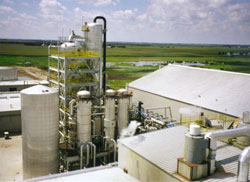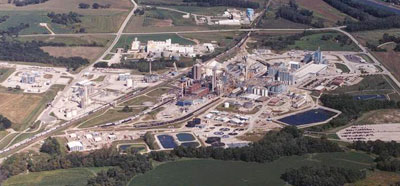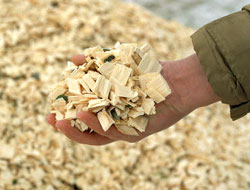LOOKING FOR A PREVIOUS STORY? CHECK THE
ARCHIVE.
Ethanol and Incentives:
Fueling a Boon or a Boondoggle?
Fueling a Boon or a Boondoggle?

Corn-ethanol plants like this one are becoming a common site with the U.S. push for alternative fuels.
Photos: National Renewable Energy Laboratory

A
t first glance, it looked like an idea fairly oozing with potential: Pump corn-based ethanol into the tanks of American autos, and voila! In one fell swoop, the U.S. could slash its toxic emissions and foreign oil dependence, in the bargain boosting the nation's long-suffering farmers. Corn-based ethanol seemed like it would yield a bumper crop of winners all around.
Or will it? A number of observers are beginning to question just how good an idea that fuel really is.
Unquestionably, it's a very expensive idea. U.S. federal and state subsidies for ethanol in 2006 totaled more than US$5 billion. Total incentives for American-made ethanol – almost all of it corn-based – equal about $1 a gallon.
"We are already subsidizing corn ethanol [in the U.S.] with more money than we spend on high-mileage cars or on quality mass transit," says Michael Dworkin, director of the Vermont Law School Institute for Energy and the Environment. "As long as we spend more on subsidizing energy suppliers than we do on investments in energy efficiency, we are on a path to pain."
But more spending on ethanol subsidies is apparently looming. When it returns from its month-long recess, the U.S. Congress will likely enact a stiff increase in taxpayers' yearly tab. A compromise committee will review separate Senate and House proposals that could jack up mandated ethanol incentives to somewhere between $131 billion and $205 billion over the next 15 years.

Ethanol production already consumes almost 25 percent of the U.S. corn crop.
Photo: National Renewable Energy Laboratory
Much more production is in the pipeline. Capitalizing on meaty incentives and national mandates, corn ethanol plants are rapidly proliferating (see accompanying "Lend Me Your Ears" chart). By the end of 2007, ethanol capacity is expected to increase to 7.5 billion gallons (28.5 billion liters) a year. Ethanol production already consumes almost 25 percent of the U.S. corn crop – twice the amount used in 2003.
So will all those gallons of corn ethanol mean a major cut in America's foreign oil dependence? No, contends Cato Institute Senior Fellow Jerry Taylor.

The Cato Institute's Jerry Taylor
"The biofuels sector is unlikely to have much impact on foreign oil imports," Taylor says in an e-mail interview from the think tank's Washington, D.C., headquarters. "If all of the corn produced in America last year were dedicated to ethanol, it would only reduce U.S. gasoline consumption by 12 percent."
What's more, whatever oil ethanol replaces won't be Middle Eastern, Taylor asserts.
"It may very well be that biofuels displace more domestic oil than foreign oil, because foreign oil is cheaper to produce than domestic crude," he says. "So biofuels will displace more expensive sources of crude oil, which come primarily from the U.S. and Canada, not the Persian Gulf."
'All Biofuels Are Not Equal'
"At first glance, ethanol produced from corn seems simple, even patriotic," says The Rush to Ethanol, a research study jointly released on July 20th by Food and Water Watch,

"Expansion of the corn ethanol industry will lead to more water and air pollution, and more soil erosion of America's farm belt, while failing to significantly offset fossil fuel use or combat global warming." Network for New Energy Choices Senior Policy Advisor Scott Cullen said while releasing The Rush to Ethanol report.

That's particularly true, the report notes, with corn. The study labels that crop as "the least sustainable biofuel feedstock of all raw materials commonly used. The capacity of corn ethanol to offset U.S. fossil fuel use is extremely limited."
"Rising oil prices, energy security and global warming concerns have led to today's 'go-yellow' hype over corn ethanol," Scott Cullen, senior policy advisor for the Network for New Energy Choices, said at the report's release. "But all biofuels are not equal. Expansion of the corn ethanol industry will lead to more water and air pollution, and more soil erosion of America's farm belt, while failing to significantly offset fossil fuel use or combat global warming."
Much of the ethanol debate centers on the issue of "net energy balance" – the ratio of a fuel's energy versus the energy required for production. With corn ethanol, that ratio accounts for a fuel with an energy content about one-third lower than normal gasoline. The Center for American Progress puts corn ethanol's energy balance at 1.34 in the Biofuels 101 report that the Washington-D.C.-based think tank released late last month.
In the larger scheme of things, though, Taylor thinks that ethanol could actually damage environmental health.
"Increasing ethanol production," he says, "will almost certainly increase greenhouse gas emissions on balance, because increasing ethanol production will mean increasing the amount of land harnessed for corn production. This invariably means migrating from more fertile to less fertile soils. That, in turn, requires more intensive energy inputs into the corn production process, primarily in the form of increased use of fertilizers and irrigation."
The United Nations voiced similar environmental concerns in May in its first major study on bioenergy. "Use of large-scale mono-cropping could lead to significant biodiversity loss, soil erosion and nutrient leaching," says the report from U.N.-Energy, Sustainable Bioenergy: A Framework for Decision Makers.
Aftershocks in the Grocery Aisles

Corn ethanol's reverberations extend to grocery prices.
Corn prices have doubled in the last two years with the acceleration in ethanol production. U.S. food prices during that period have increased as well, since about one-fourth of grocery store items contain corn. Beef and poultry products are also becoming more expensive; corn is dairy farmers' primary feed and makes up about three-fourths of poultry farmers' feed.
Corn ethanol production can also affect other fuels' costs. A Massachusetts Institute of Technology study, for example, reports that natural-gas prices are under strain, since that fuel now provides about two-thirds of the energy that's used in U.S. ethanol production.
High-profile political figures, however, rarely mention such cautionary facts. Most seem to find alternative fuels made from American corn simply irresistible.
That list includes George W. Bush, long criticized by some as a global warming denier. The president backed the 2005 Energy Bill that mandated that U.S. refiners by 2012 blend as much as 7.5 billion gallons (28.5 billion liters) of ethanol with the gas they sell. That same bill increased ethanol subsidies to 51 cents a gallon – almost all of it going to the oil companies that blend it with their gasoline. Bush's ethanol support escalated in his 2007 State of the Union address, where he called for producing 35 billion gallons (133 billion liters) of alternative fuels by 2017.
The Politics of Corn
The biofuels industry is big in Iowa. Ethanol and biodiesel ventures accounted for 50 percent of the Hawkeye State projects reported during first-quarter 2007

Cargill is investing $267 million in expanding ethanol production at its 1,600-acre (640-hectare) campus in Eddyville, Iowa (pictured).
Photo: Iowa State University Dept. of Agricultural and Biosystems Engineering
Unsurprisingly, seldom is heard a discouraging word about corn-based ethanol out along the Iowa campaign trail.
"What you've done with ethanol, you're setting the pace," Hillary Clinton said in a speech in the Hawkeye State last month. That stance is the norm in Iowa, where the candidates' praise for corn ethanol has grown as high as an elephant's eye.
"Elected officials are primarily motivated by the hunt for political capital, including campaign contributions but, most importantly, votes," says the Cato Institute's Taylor. "As long as they believe that ethanol subsidies will deliver political capital, they will vote for ethanol subsidies."
But that, he adds, is only a reflection of the body politic.
"The problem isn't that politicians are wrong-headed about ethanol," says Taylor. "The problem is that voters are wrong-headed about ethanol."
Can Cellulosic Fill the Gap?

Switchgrass and wood chips are two of the feedstocks that can be used in producing cellulosic ethanol.

"Any ethanol funding in the U.S. Farm Bill should focus on research and development of cellulosic ethanol," says The Rush to Ethanol report. "There is sufficient private investment in corn ethanol development and refining already."
Supporters of cellulosic ethanol contend that the fuel has a number of advantages. For one thing, it can be made from a wide range of inexpensive and readily available feedstocks, including switchgrass, wood chips and straw. Cellulosic ethanol's net energy balance is also twice as high as corn ethanol's. Moreover, some researchers estimate that cellulosic ethanol has the potential to reduce greenhouse emissions by more than 90 percent – about four and a half times more than corn ethanol.
For certain, some biofuel feedstock other than corn will have to be employed if Congress enacts the mandate to produce 35 billion gallons (133 billion liters) of alternative fuel a year by 2017. U.S. corn can, at the uppermost, provide only 15 billion gallons (57 billion liters) of ethanol a year, most agricultural analysts agree.
High Costs Slow Progress
"Cellulosic ethanol is even less economically competitive with gasoline than corn ethanol," says Taylor. "[Energy Information Administration Administrator] Guy Caruso noted in a speech last November that the capital costs associated with cellulosic ethanol production were five times greater than those associated with conventional corn ethanol production.
"The USDA estimates that the capital costs associated with corn ethanol production work out to about $1.50 per gallon," he continues. "That suggests that cellulosic ethanol would cost about $7.50 per gallon – before we even consider the price of the feedstock."
The U.S. Department of Agriculture is seeking $1.6 billion for cellulosic research and production in the 2007 Farm Bill.
"The costs associated with cellulosic ethanol might well come down over time," Taylor allows, "but it is [now] far less economically competitive than any number of gasoline alternatives such as synthetic fuel from coal. Predictions about the 'fuels of the future' have been uniformly wrong over time, and there's little reason to pick cellulosic ethanol rather than any number of gasoline alternatives as our best bet."
The alternative fuels scenario, then,

Food & Water Watch's Wenonah Hauter
Meanwhile, the world continues to work with the alternative fuel options that are on the table. And in the U.S., it seems inevitable that work is going to mean higher government subsidies – a prospect that doesn't please Taylor and the free-market-championing Cato Institute.
"If ethanol made economic sense, it wouldn't need to be mandated or subsidized," Taylor asserts. "The government should not be in the business of promoting any particular industry. If an investment in industry x, y, or z has economic merit, then market actors will make those investments."
Even farmers won't profit from current U.S. strategies for alternative fuels, contends Food & Water Watch Executive Director Wenonah Hauter.
"Rural communities won't benefit from the Farm Bill becoming a fuel bill," Hauter said on July 20th. "In the long run, family farmers and the environment will be losers, while agribusiness, whose political contributions are fueling the ethanol frenzy, will become the winners."

Photo: USDA
Lend Me Your Ears
New corn ethanol plants have been sprouting up in the U.S. with dizzying frequency with the nation's alternative fuels initiative. Here's a sampling of some of the biggest of those new facilities that have been reported to Site Selection over the past two and a half years, arranged in order of investment.
|
||
| Company | Location | Investment
(in U.S. millions) |
| Archer Daniels Midland | Cedar Rapids, Iowa | $542 |
| International Bio Energy Virginia | Chesapeake, Va. | $500 |
| Aventine Renewable Energy Holdings | Mount Vernon, Ind. | $400 |
| Waverly Ethanol LLC/Robert Johnson | Waverly, Ill. | $300 |
| Cargill Inc. | Eddyville, Iowa | $267 |
| Ethanex Energy Inc./SEMO Milling LL | Cape Girardeau, Mo. | $260 |
| Aura Renewable Energy | Beaver Falls, N.Y. | $250 |
| Bioenergy International | Clearfield County, Pa. | $250 |
| Alternative Energy Sources Inc. | Kankakee, Ill. | $225 |
| Alternative Energy Sources Inc. | Greenville, Ill. | $220 |
| Council Bluffs Ethanol | Council Bluffs, Iowa | $214 |
| Lincolnway Energy | Nevada, Iowa | $214 |
| Red Oak Ethanol | Red Oak, Iowa | $213 |
| Chief Energy Co. | Sioux City, Iowa | $210 |
| Global Ethanol | Belmond, Iowa | $210 |
| Abengoa Bioenergy Corp./Abengoa S.A. | Madison, Ill. | $200 |
| Agri-Ethanol Products | Batesburg, S.C. | $200 |
| Altra Inc. | Carleton, Neb. | $200 |
| E85, Inc. | Cumberland County, N.C. | $200 |
| Ecron Corp. | Sparrows Point, Md. | $200 |
| Ethanol Production Co. LLC | Kewanee, Ill. | $200 |
| Hartford Bio-Energy LLC | Hartford City, Ind. | $200 |
| Heartland Ethanol LLC | Griggsville, Ill. | $200 |
| Indeck Energy Services | Niles Mich. | $200 |
| Mississippi-Ohio River Energy | Pulaski Ill. | $200 |
| Ripatti Group, Inc. | Pike County, Ind. | $200 |
| U.S. Ethanol Holdings LLC | Wasco, Calif. | $200 |
| Voyager Ethanol, LLC/Broin Companies | Emmetsburg, Iowa | $200 |
| Source: Conway Data's New Plant Database, January 2005-July 2007 | ||
| CONTINUE TO THE LATEST EDITION OF “BLOCKBUSTER DEAL OF THE WEEK” | |
| RETURN TO: SITESELECTION.COM
| LOOKING FOR A PREVIOUS STORY? CHECK THE ARCHIVE.
|
 PLEASE
VISIT OUR SPONSOR • CLICK ABOVE
PLEASE
VISIT OUR SPONSOR • CLICK ABOVE 